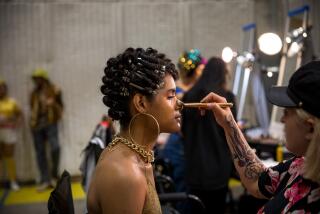Inclusion and representation in Hollywood films stagnant since 2007, new study finds
- Share via
Despite women and people of color at the helm of high-profile successes like “Black Panther,” “Get Out,” “Girls Trip” and “Wonder Woman,” a new study has found that diversity of representation among Hollywood films remains largely unchanged from a decade ago.
The study, published by the USC Annenberg School for Communication and Journalism, found that among 1,100 popular films released between 2007 and 2017, there’s been little to no improvement regarding the inclusion of women, people of color, or members of the LGBTQ or disabled communities.
Though 33 of 2017’s top 100 films featured a woman as a lead or co-lead, just four of them were led by a woman of color, the study found.
“When Hollywood discusses women they are thinking of white women,” said Stacy L. Smith, the report’s co-writer. “But these trends seem to be relatively stable in terms of who’s getting work, whether it’s driving storytelling or it’s the entire ecosystem of all speaking characters. We’re seeing very little movement across the board, but once we cross gender with other factors, the story becomes really problematic.”
Of 4,454 speaking characters in the top 100 films of 2017, just 31.8% were women, the study reported. That percentage has remained relatively consistent since 2007, hitting a peak of 32.8% in 2008 and 2009 and a nadir of 28.1% in 2014.
Among characters with speaking roles in the top 100 films of 2017, 29.3% were minorities, 2.5% had disabilities and less than 1% were members of the LGBTQ community. (The annual study has been tracking LGBTQ inclusion since 2014 and disabled inclusion since 2015, with the percentages again consistent.)
“We see slight deviations in haphazard ways but nothing that seems to suggest meaningful change happening,” Smith said.
The study also explored the frequency with which female characters of color were excluded from major films last year: 65 films featured no characters of Asian descent, 64 had no Latina characters and 43 lacked a black female character (comparatively, just seven films were missing a white female character).
Characters from the LGBTQ and disabled communities fared far worse: LGBTQ women were not included in 94 films while disabled women were absent from 78 films. Of 400 popular films released between 2014 to 2017, only one transgender character appeared on screen.
Behind the scenes, representation is just as bad. 81.7% of people working as directors, writers and producers on the top 100 releases of 2017 were men and 18.2% were women.
Among 1,223 directors over 11 years, 5.2% were black or African American, 4.3% were women and 3.1% were of Asian descent. That translates to four black or African American women, three Asian or Asian American women and one Latina directing a film across the 1,100 examined.
“The behind-the-camera numbers are absolutely at a standstill,” said Smith. “If we’re not seeing inclusion behind the camera, then the patterns on screen are going to be impervious to change. The only way to make storytelling move is by thinking differently in how directors, writers, etc. get attached to projects.”
While it’s easy to interpret films like the upcoming “The Spy Who Dumped Me” and “Crazy Rich Asians” as representing verifiable change in Hollywood, there are still more than two men appearing on screen for every one female among speaking roles.
Ageism also remains an issue in the industry. Among the top 100 movies of 2017, 30 included a male character over the age of 45 and only five films featured a woman in the same age bracket. Only one was led by a woman of color 45 or older.
Although change has been slow in coming, Smith is hopeful that heightened awareness about these issues can lead to change if supported with industry-wide action.
“The conversation has been absolutely important,” she said. “That’s step one: getting communities engaged. And expressing their reactions and resistance to the way Hollywood has done business has been key to really countering the way in which Hollywood has thought about these decisions.
“What hasn’t worked is the activism around trying to change any of these numbers,” she added. “Moving forward, there’s only one area that has to be targeted: Companies need to make public commitments to change and they have to have a strategy to meet the target inclusion goal when it comes to hiring.”
Smith highlights nepotism and deals brokered between friends and in closed networks as contributors to this employment issue.
“Access and opportunity should be given to individuals that are talented, qualified and available for the job and that’s not how these deals are brokered,” she said. “So until hiring is targeted and activists rally around that one key exclusionary preface, these numbers won’t move.”
Reports like these alone aren’t enough to remedy the issue, Smith said.
“Studies don’t move the needle. Everybody likes to get the attention of drawing the focus on the issues but that’s not what moves the needle. Changing hearts and minds, that isn’t what changes this problem.”
Instead, she proposed, change the nature of the business.
“Given that people are flocking from film and going to television and streaming content, a better strategy would be for executives in the film industry to move away from their narrow imaginations and actually think critically about the diversity of the audience and serving their needs. If hiring practices do not change, then in 10 years we’re going to find the exact same thing.”
follow me on twitter @sonaiyak
More to Read
Only good movies
Get the Indie Focus newsletter, Mark Olsen's weekly guide to the world of cinema.
You may occasionally receive promotional content from the Los Angeles Times.











